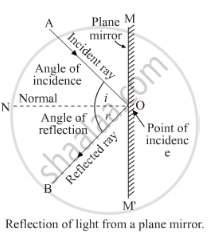Advertisements
Advertisements
Question
State and explain the laws of reflection of light at a plane surface (like a plane mirror), With the help of a labelled ray-diagram. Mark the angles of 'incidence' and 'reflection' clearly on the diagram. If the angle of reflection is 47.5°, what will be the angle of incidence?
Solution

a) The two laws of reflection are:
- The angle of incidence is always equal to the angle of reflection . If the angle of incidence is i and the angle of reflection is r, then, according to the first law of reflection, .`∠i=∠r`
- The second law of reflection states that the incident ray, the reflected ray and the normal (at the point of incidence), all lie in the same plane. For example, in the figure, the incident ray AO, the reflected ray OB and the normal ON, all lie in the same plane.
(b) If the angle of reflection is 47.5°, the angle of incidence will also be 47.5° in accordance with the first law of reflection, which states that the angle of reflection is always equal to the angle of incidence.
APPEARS IN
RELATED QUESTIONS
Where is the image when you look at something in a mirror?
An extended object in the form of an arrow pointing upward has been placed in front of a plane mirror. Draw a labelled ray-diagram to show the formation of its image.
Name the phenomenon due to which a swimming pool appears less deep than it really is.
Show the lateral displacement of the ray on the diagram.
A vertical ray of light strikes the horizontal surface of some water:
What is the angle of refraction?
Explain with diagrams how refraction of incident light takes place from
- rarer to denser medium
- denser to rarer medium
- normal to the surface separating the two media.

The angle of incidence from air to glass at the point O on the hemispherical glass slab is.
The phenomenon of light passing through the object is called ______.
Assertion: The air bubble shines in water.
Reason: Air bubble shines due to the refraction of light.
In refraction of light through a glass slab, the directions of the incident ray and the refracted ray are ______.
